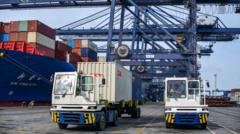The Indonesian government recently revoked several nickel mining permits in Raja Ampat, known for its rich biodiversity. While this decision reflects public outcry and conservation efforts, environmentalists warn of potential reversals and existing ecological damage, highlighting the conflict between mining for EV battery metals and protecting vulnerable marine ecosystems.
Balancing Energies: The Environmental Toll of Nickel Mining in Raja Ampat

Balancing Energies: The Environmental Toll of Nickel Mining in Raja Ampat
Amidst the race for sustainable energy solutions, nickel mining in Indonesia's Raja Ampat presents significant ecological challenges, raising concerns over the future of this marine paradise.
The Raja Ampat archipelago in Indonesia, often heralded as the "Amazon of the Seas," is facing unprecedented ecological threats due to nickel mining activities that support the burgeoning electric vehicle (EV) market. Stark visuals captured by environmental activists and shared through BBC highlight the alarming degradation within this biodiverse marine region, marked by deforestation and water pollution attributed to mining.
As nickel, a key component in EV batteries and stainless steel, becomes increasingly sought after, mining operations in Raja Ampat have escalated. Global Witness reports that the Indonesian government has recently revoked permits for four out of five mining companies operating in the area, a move that has garnered positive reactions from environmental advocates.
The Indonesian Ministry for the Environment emphasized the importance of preserving Raja Ampat's rich biodiversity, stating, "Raja Ampat's biodiversity is a world heritage that must be protected." Nevertheless, drone imagery from Global Witness illustrates the damage already inflicted upon the archipelago, such as forest loss and sediment runoff, negatively impacting the underwater ecosystems that host some of the world's most diverse coral reefs.
Between 2020 and 2024, land designated for mining in Raja Ampat reportedly increased by 500 hectares, raising alarms among conservationists. Despite the government’s actions, concerns linger regarding potential legal challenges from mining companies that could negate current protections, especially as one firm continues operations on Gag island, known for its valuable nickel deposits.
Dr. Mark Erdmann, a seasoned conservationist, expressed his relief at the government's decision yet acknowledged the lingering threats, emphasizing the complexity of balancing economic growth with the preservation of ecological integrity. “It was a voice of outrage from Indonesian people that made the government pay attention,” he noted.
While the government positions Indonesia as a leader in the global nickel market, studies reveal the paradoxical impact of mining on local communities, including worsening environmental safety and air quality. Dr. Michaela Guo Ying Lo noted that while mining has provided some economic benefits, the increased pollution risks threaten the overall well-being of affected populations.
Environmental campaigner Imam Shofwan condemned the narrative that promotes nickel mining as a panacea for the climate crisis, asserting that it destructively affects local agriculture and fishing industries. He reminded that many mining sites are situated in low-lying coastal areas susceptible to climate change impacts, including rising sea levels.
Ultimately, the dilemma posed by nickel mining in Raja Ampat raises critical questions about the sacrifices we are willing to accept for the sake of green technology. The discourse surrounding the future of Raja Ampat's unique ecosystems is a reflection of a larger global struggle to balance the urgent demand for sustainable energy resources with environmental preservation. As the debate continues, the long-term fate of Raja Ampat’s marine environment hangs in the balance.



















